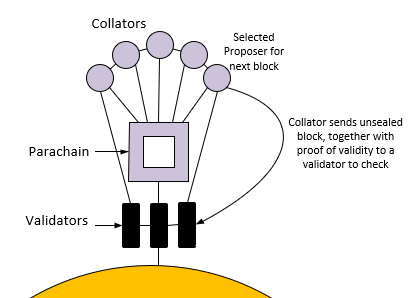Collator
This page provides a general overview of the role of collators' in the Polkadot ecosystem. For more detailed information you can read the Parachain Protocol Overview.
Collators' Role
Collators maintain parachains by collecting parachain transactions from users and producing state transition proofs for relay chain validators. In other words, collators maintain parachains by aggregating parachain transactions into parachain block candidates and producing state transition proofs (Proof-of-Validity, PoV) for validators.
Collators maintain a full node for the relay chain and a full node for their particular parachain; meaning they retain all necessary information to be able to author new blocks and execute transactions in much the same way as miners do on PoW blockchains. Under normal circumstances, they will collate and execute transactions to create an unsealed block and provide it, together with a PoV, to one or more validators responsible for proposing a parachain block.
Collators are similar to validators on any other blockchain but they do not need to provide security guarantees because the relay chain provides those. If a parachain block is invalid, it will get rejected by validators. The validators are required to check the validity of submitted candidates, followed by issuing and collecting statements about the validity of candidates to other validators. This process is known as candidate backing. Validators receive an arbitrary number of parachain candidates with associated PoV from untrusted collators. A candidate is considered backable when at least 2/3 of all assigned validators have issued a valid statement about that candidate.
The validator must successfully verify the following conditions in the following order:
-
The candidate does not exceed any parameters in the persisted validation data.
-
The signature of the collator is valid.
-
Validate the candidate by executing the parachain Runtime.
Once a candidate meets a specified criteria for inclusion, the selected relay chain block author then chooses any of the backable candidates for each parachain and includes those into the relay chain block. We say the candidate blocks are backed.
The assumption that having more collators is better or more secure is not correct. On the contrary, too many collators may slow down the network. The only nefarious power collators have is transaction censorship. To prevent censorship, a parachain only needs to ensure that there are some neutral collators - but not necessarily a majority. Theoretically, the censorship problem is solved by having just one honest collator.
XCM
Collators are a key element of the XCM (Cross-Consensus Message Passing Format). By being full nodes of the relay chain, they are all aware of each other as peers. This makes it possible for them to send messages from parachain A to parachain B.
Taking the Case for One Parachain
A start of a new block candidate is initiated with a block creation time. The collator aggregates all new transactions at the end of the process. When doing so, the collator signs the parachain block candidate and produces state transition proofs (Proof-of-Validity, PoV), which are a summary of the final account balances caused by the transactions in the candidate block. The collator sends the candidate block and PoV to the parachain validators, so-called para-validators. The para-validators verify the transactions within the parachain block candidate. Upon verification, and if all is well, the candidate becomes backable and a para-validator shares the candidate block with the relay chain.

The validators on the relay chain will try to reach a consensus on the block candidate. Upon reaching consensus, the now validated block candidate is shared with the validators and collators, and the process repeats for new transactions. A collator cannot continue building blocks on a parachain until the block candidate they proposed to the relay chain validators have been validated. A block is produced every 6 seconds.
Collators in the Wild
Blockchains that are built using Substrate are unable to hook onto the relay chain on their own. The Parity team built the Cumulus library to address this. Collators are being used on the Paseo testnet, and you can learn more about how they are used with Cumulus via the Cumulus Rust documentation. More information can be found under the Cumulus section on the build parachain page.
Guides and Tools
- Tutorial covering Cumulus and Collators
- Paseo testnet guide
- polkadot-launch - a tool to quickly spin up a local Polkadot testnet based on some parameters like number of parachains, collator setup, etc.